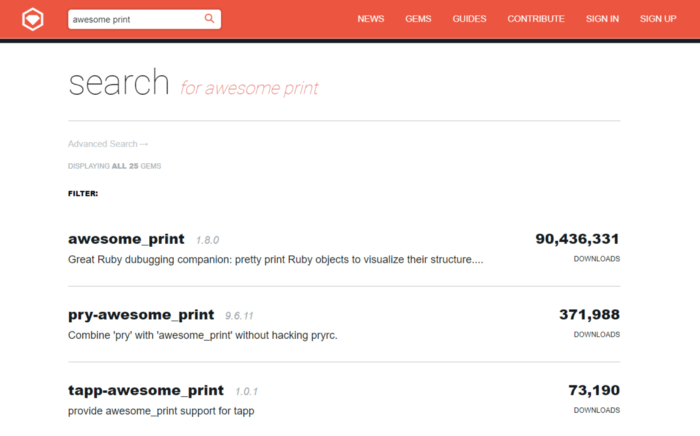Docker is a platform for developers and sysadmins to develop, ship, and run applications. Docker lets you quickly assemble applications from components and eliminates the friction that can come when shipping code. Docker lets you get your code tested and deployed into production as fast as possible.
Docker for Mac
- The following instructions for installing Ruby have been tested on Mac OS X Yosemite (10.10.4). They should work fine with Mac OS X El Capitan (10.11.1) or Mavericks (10.9.5) as long as you’re running the latest updates for that version of Mac OS X: 1 Open the Applications folder,.
- Download RubyGems - Self Contained Ruby Libraries for free. RubyGems is a system used to package other Ruby libraries into single, self-contained files that also contain metadata about the library, such as name, category, dependencies, etc.
Solution for Mac. Install PostgreSQL library as described on the PostgreSQL page (opening the.dmg file will install a bunch of stuff, so don’t be afraid of the amount of steps you have to perform) check if you can find the installation open it under /Library/PostgreSQL/x.y - where x.y stands for the version you installed.
Docker for Mac is the current release of Docker for OSX. Requirements:
- Mac must be 2010 or new model with Intel's hardare support for memory management unit (MMU, virtualization, and Unrestricted mode.
- OSX El Capital 10.11 and newer releases are supported.
- Virtualbox prior to version 4.3.30 must NOT be installed. It is incompatiable. Use a newer version.
Install Docker for Mac
Docker for Mac can be downloaded here.
Docker Toolbox
Docker Toolbox is a legacy desktop solution for older Mac and Windows systems that do not meet the requirements of Docker for Mac and Docker for Windows.
Before you install Docker Toolbox
In order to simplify the installation process you should install homebrew-cask which provides a friendly homebrew-style CLI workflow for the administration of Mac applications distributed as binaries. Refer to this article in order to install homebrew-cask.
Install Docker Toolbox
Use can use cask to install Docker Toolbox which is a collection of useful docker tools such as compose, machine and Kitematic.
Docker Toolbox Quick Start
For quick start find the Docker Quickstart Terminal and double click to launch it. Then you start the hello world container using:
You can find more about docker follow the documentation here.
The listen gem listens to file modifications and notifies you about the changes.
Listen is currently accepting more maintainers. Please read this if you're interested in joining the team.

Features
- OS-optimized adapters on MRI for Mac OS X 10.6+, Linux, *BSD and Windows, more info below.
- Detects file modification, addition and removal.
- You can watch multiple directories.
- Regexp-patterns for ignoring paths for more accuracy and speed
- Increased change detection accuracy on OS X HFS and VFAT volumes.
- Continuous Integration: tested on selected Ruby environments via Github Workflows.
Issues / limitations
- Limited support for symlinked directories (#279):
- Symlinks are always followed (#25).
- Symlinked directories pointing within a watched directory are not supported (#273- see Duplicate directory errors).
- No directory/adapter-specific configuration options.
- Support for plugins planned for future.
- TCP functionality was removed in
listen3.0.0 (#319, #218). There are plans to extract this feature to separate gems (#258), until this is finished, you can use by locking thelistengem to version'~> 2.10'. - Some filesystems won't work without polling (VM/Vagrant Shared folders, NFS, Samba, sshfs, etc.).
- Specs suite on JRuby and Rubinius aren't reliable on Travis CI, but should work.
- Windows and *BSD adapter aren't continuously and automatically tested.
- OSX adapter has some performance limitations (#342).
- FreeBSD users need patched version of rb-kqueue (as of 2020/11). See #475 for the issue, mat813/rb-kqueue#12 for the patch, and Bug 250432 in bugzilla.
- Listeners do not notify across forked processes, if you wish for multiple processes to receive change notifications you must listen inside of each process.
Pull requests or help is very welcome for these.
Install
The simplest way to install listen is to use Bundler.
Complete Example
Here is a complete example of using the listen gem:
Running the above in the background, you can see the callback block being called in response to each command:
Usage
Call Listen.to with one or more directories and the 'changes' callback passed as a block.
Changes Callback
Changes to the listened-to directories are reported by the listener thread in a callback.The callback receives three array parameters: modified, added and removed, in that order.Each of these three is always an array with 0 or more entries.Each array entry is an absolute path.
Pause / unpause / stop
Listeners can also be easily paused/unpaused:
Note: While paused, listen keeps on collecting changes in the background - to clear them, call stop.
Note: You should keep track of all started listeners and stop them properly on finish.
Ignore / ignore!
Listen ignores some directories and extensions by default (See DEFAULT_IGNORED_DIRECTORIES and DEFAULT_IGNORED_EXTENSIONS in Listen::Silencer).You can add ignoring patterns with the ignore option/method or overwrite default with ignore! option/method. Beck depression inventory online download.
Note: :ignore regexp patterns are evaluated against relative paths.
Note: Ignoring paths does not improve performance, except when Polling (#274).
Only
Listen watches all files (less the ignored ones) by default. If you want to only listen to a specific type of file (i.e., just .rb extension), you should use the only option/method.
Note: :only regexp patterns are evaluated only against relative file paths.
Options
All the following options can be set through the Listen.to after the directory path(s) params.
Logging and Debugging
How To Install And Run Ruby On Mac OS X - Dummies
Listen logs its activity to Listen.logger.This is the primary method of debugging.
Custom Logger
You can call Listen.logger = to set a custom listen logger for the process. For example:
Default Logger
If no custom logger is set, a default listen logger which logs to to STDERR will be created and assigned to Listen.logger.

The default logger defaults to the error logging level (severity).You can override the logging level by setting the environment variable LISTEN_GEM_DEBUGGING=<level>.For <level>, all standard ::Logger levels are supported, with any mix of upper-/lower-case:
The default of error will be used if an unsupported value is set.
Note: The alternate values 1, 2, true and yes shown above are deprecated and will be removed from listen v4.0.
Disabling Logging
If you want to disable listen logging, set
Listen Adapters
The Listen gem has a set of adapters to notify it when there are changes.
There are 4 OS-specific adapters to support Darwin, Linux, *BSD and Windows.These adapters are fast as they use some system-calls to implement the notifying function.
There is also a polling adapter - although it's much slower than other adapters,it works on every platform/system and scenario (including network filesystems such as VM shared folders).
The Darwin and Linux adapters are dependencies of the listen gem so they work out of the box. For other adapters a specific gem will have to be added to your Gemfile, please read below.
The listen gem will choose the best adapter automatically, if present. If youwant to force the use of the polling adapter, use the :force_polling optionwhile initializing the listener.
On Windows
If you are on Windows, it's recommended to use the wdm adapter instead of polling.
Please add the following to your Gemfile:
On *BSD
If you are on *BSD you can try to use the rb-kqueue adapter instead of polling.
Please add the following to your Gemfile:
Getting the polling fallback message?
Please visit the installation section of the Listen WIKI for more information and options for potential fixes.
Issues and Troubleshooting
If the gem doesn't work as expected, start by setting LISTEN_GEM_DEBUGGING=debug or LISTEN_GEM_DEBUGGING=info as described above in Logging and Debugging.
NOTE: without providing the output after setting the LISTEN_GEM_DEBUGGING=debug environment variable, it is usually impossible to guess why listen is not working as expected.
See TROUBLESHOOTING
Performance
Cached
If listen seems slow or unresponsive, make sure you're not using the Polling adapter (you should see a warning upon startup if you are).
Also, if the directories you're watching contain many files, make sure you're:
- not using Polling (ideally)
- using
:ignoreand:onlyoptions to avoid tracking directories you don't care about (important with Polling and on MacOS) - running
listenwith the:latencyand:wait_for_delayoptions not too small or too big (depends on needs) - not watching directories with log files, database files or other frequently changing files
- not using a version of
listenprior to 2.7.7 - not getting silent crashes within
listen(seeLISTEN_GEM_DEBUGGING=debug) - not running multiple instances of
listenin the background - using a file system with atime modification disabled (ideally)
- not using a filesystem with inaccurate file modification times (ideally), e.g. HFS, VFAT
- not buffering to a slow terminal (e.g. transparency + fancy font + slow gfx card + lots of output)
- ideally not running a slow encryption stack, e.g. btrfs + ecryptfs
When in doubt, LISTEN_GEM_DEBUGGING=debug can help discover the actual events and time they happened.
See also Tips and Techniques.
Development
- Documentation hosted at RubyDoc.
- Source hosted at GitHub.

Pull requests are very welcome! Please try to follow these simple rules if applicable:
- Please create a topic branch for every separate change you make.
- Make sure your patches are well tested. All specs must pass on Travis CI.
- Update the Yard documentation.
- Update the README.
- Please do not change the version number.
For questions please join us in our Google group or on#guard (irc.freenode.net).
Releasing
Rubygems Issues For Mac Catalina
Prerequisites
- You must have commit rights to the GitHub repository.
- You must have push rights for rubygems.org.
How to release
- Run
bundle installto make sure that you have all the gems necessary for testing and releasing. - Ensure all tests are passing by running
bundle exec rake. - Determine which would be the correct next version number according to semver.
- Update the version in
./lib/listen/version.rb. - Update the version in the Install section of
./README.md(gem 'listen', '~> X.Y'). - Commit the version in a single commit, the message should be 'Preparing vX.Y.Z'
- Run
bundle exec rake release:full; this will tag, push to GitHub, and publish to rubygems.org. - Update and publish the release notes on the GitHub releases page if necessary
Acknowledgments
- Michael Kessler (netzpirat) for having written the initial specs.
- Travis Tilley (ttilley) for this awesome work on fssm & rb-fsevent.
- Natalie Weizenbaum (nex3) for rb-inotify, a thorough inotify wrapper.
- Mathieu Arnold (mat813) for rb-kqueue, a simple kqueue wrapper.
- Maher Sallam for wdm, windows support wouldn't exist without him.
- Yehuda Katz (wycats) for vigilo, that has been a great source of inspiration.

Rubygems Issues For Mac Os
Author
Rubygems Issues For Mac Computers
Thibaud Guillaume-Gentil (@thibaudgg)
Rubygems Issues For Mac Operating System
Contributors
